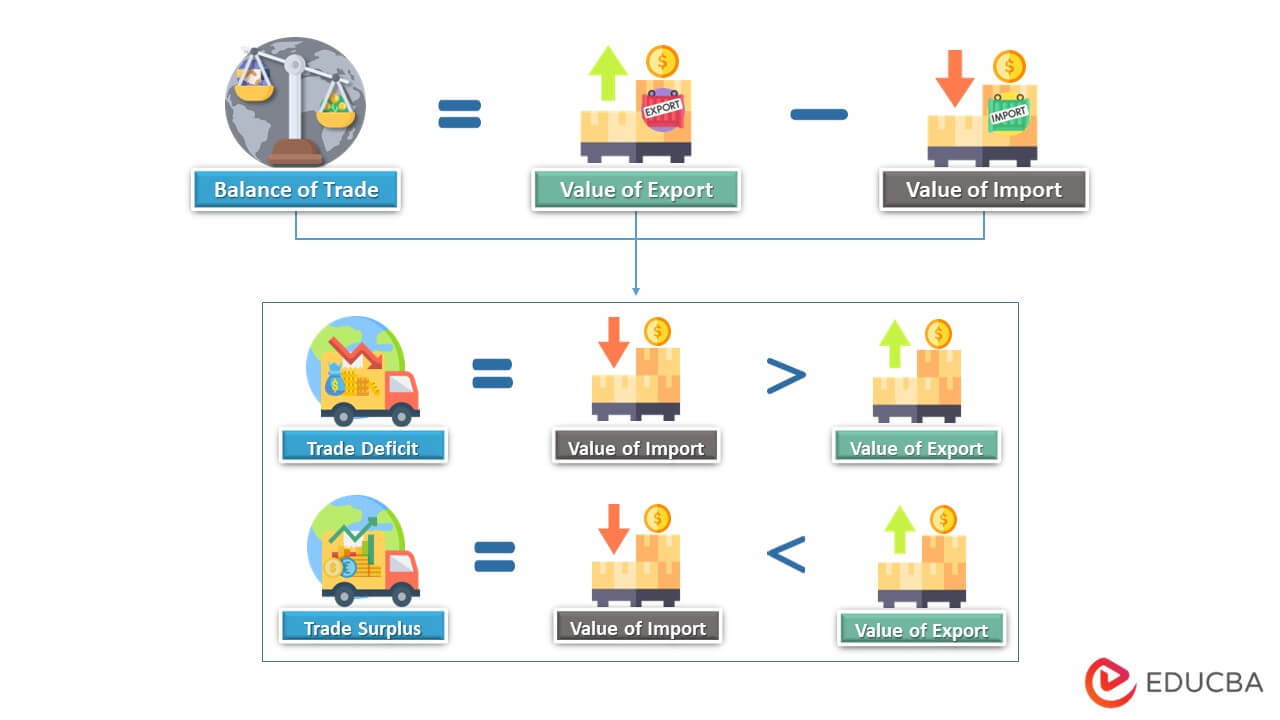Updated July 7, 2023
What is the Balance of Trade?
The balance of trade (BOT) is a measurement of a country’s exports compared to its imports. For example, the exports and imports of the US stand at $258 Billion and $331.3 Billion, respectively, as of November 2022. The country is in a trade deficit because the trade balance is negative (-$73.3). Therefore, the US has a $73.3 billion deficit in it.
It can measure a country’s economic health and relations with other countries. A positive BOT shows a country’s trade surplus, while a negative BOT indicates a deficit. It means a country has a trade deficit when it imports more than it exports and vice versa. It is also known as net exports.
Key Highlights
- A BOT is an economic metric that measures the gap in a nation’s importing and exporting values.
- It is of three types: favorable, unfavorable, and equilibrium
- To calculate this value, economists usually subtract imports from exports
- It is a crucial economic indicator of a country’s trading practices and helps analyze its global standing
- While the BOT is the import-export difference, the balance of payment is the transactional record of a nation’s capital inflow and outflow.
Real World Examples
Example #1:
The September report shows that the United Kingdom has a total trade deficit of $3.13 billion for 2022. It fell from $5.53 billion in 2021. The primary reason for this downfall is the decrease in oil prices which reduces the value of imports.
Example #2:
India’s trade balance shows a deficit of $25.7 billion as of September 2022. It is a recovery from $27.8 billion, a record low it saw in July 2022.
Example #3:
China’s trade surplus is growing even though the world of commerce has decreased due to the epidemic. From $458.93 billion in 2021, it now stands at $519.53 billion. It keeps reducing its imports and increasing its exports to achieve a higher trade surplus.
Types
Favorable
- It indicates that exports are higher than imports, resulting in a net gain for the country
- Countries with a favorable trade balance can often reduce shipping and import costs due to their strong trading relationships with other countries.
Unfavorable
- It means that imports are more than exports, resulting in a net loss for the country.
- A weak currency is one of the common reasons for unfavorable BOT, as it makes exports expensive while imports become cheaper.
Equilibrium
- It is when both exports and imports are equal in value
- It can be either because both trading countries are satisfied with the trade or are significantly damaged by the imbalance.
How to Calculate Balance of Trade?
To calculate the BOT, use the following formula,
- Gather the necessary data regarding the nation’s exports and imports value for the specific period
- Calculate the difference between both values by subtracting the value of imports from the exports
- A positive result indicates a trade surplus, while a negative number indicates a trade deficit
- For example, let’s say that Country A has exports totaling $50 billion and imports totaling $40 billion. The trade balance would be $50 billion less $40 billion, which is $10 billion. It indicates that Country A has a trade surplus of $10 billion.
Balance of Trade vs. Balance of Payment
| Balance Of Trade | Balance Of Payment |
| Definition | |
| It is the difference in value between the goods/services it buys and sells during a specific period. | It is a record of all of its international economic deals and transactions |
| Calculation | |
| It is generally the net exports, i.e., exports minus imports | It is a sum of a country’s current, capital, and financial account along with its trade balance |
| Impact | |
| The overall impact can be positive, negative, or zero | The result will always be zero |
| Major difference | |
| It does not consider any international capital transfers. | It includes all capital transfers for its calculation. |
Importance
- It includes goods and services, presenting a more accurate picture of a country’s overall economic health and stability.
- It also affects a nation’s currency values, inflation, and interest rates
- It provides an understanding of a country’s competitiveness in global markets
- It can help evaluate the trade relationship among various economies.
Final Thoughts
The BOT is an essential factor to consider when looking at the health of a country’s economy. It is a necessary factor in a country’s economic stability and prosperity. Therefore, nations must carefully manage their imports and exports to ensure a healthy trade balance.
Frequently Asked Questions(FAQs)
Q1. What are the causes of the BOT?
Answer: All variables that impact international commerce affect a country’s trade balance. A few significant causes are trade policies, currency reserves, inflation, exchange rates, and aggregate demand & supply.
Q2. How does the BOT affect a country’s economy?
Answer: A country with a strong trade balance can weather economic downturns and maintain a healthy economy. They can even pay for imports without borrowing or selling off assets. A country with an export surplus tends to see its currency appreciate, making its exports more affordable for other countries and stimulating economic growth.
Conversely, a country with an unfavorable trade balance will see its currency depreciate, making its imports more expensive and slowing economic growth.
Q3. What are some factors that change the BOT?
Answer: Several factors can lead to changes in the trade balance. These factors include goods/services, exchange rates, and government policies. In addition, changes in global demand for different economic factors can affect imports and exports.
Recommended articles
This article explains the BOT. We discuss its definition, types, formula, calculation, and examples. Read the following recommended articles for more information,


